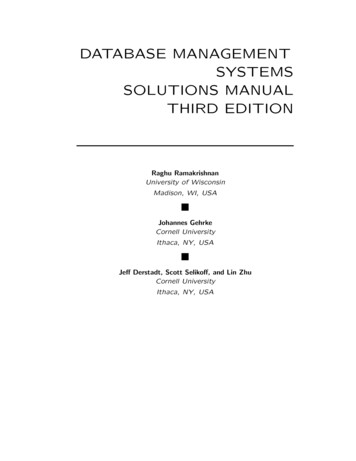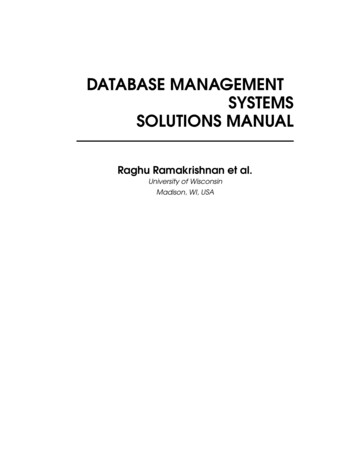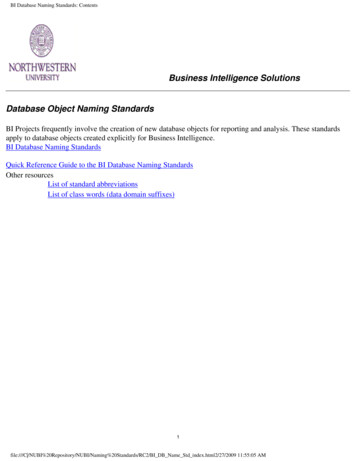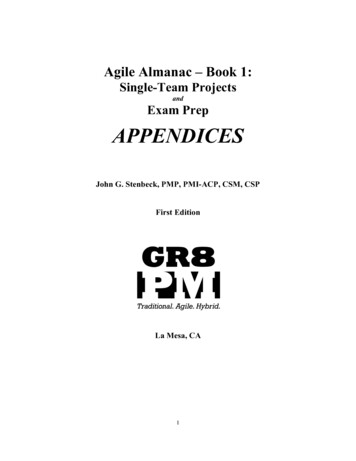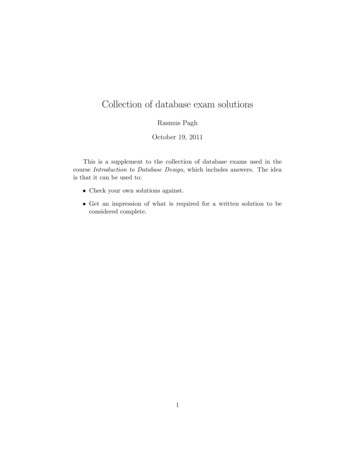
Transcription
Collection of database exam solutionsRasmus PaghOctober 19, 2011This is a supplement to the collection of database exams used in thecourse Introduction to Database Design, which includes answers. The ideais that it can be used to: Check your own solutions against. Get an impression of what is required for a written solution to beconsidered complete.1
Data Storage and FormatsIT Universitety of CopenhagenJanuary 5, 2009This exam is a translation, by Michael Magling, of an original Danish language exam.It consists of 6 problems with a total of 15 questions. The weight of each problem is stated.You have 4 hours to answer all questions. The complete assignment consists of 11 pages(including this page). It is recommended to read the problems in order, but it isnot important to solve them in order.If you cannot give a complete answer to a question, try to give a partial answer.The pages in the answer must be ordered and numbered, and be supplied with name,CPR-number and course code (BDLF). Write only on the front of sheets, and order themso that the problems appear in the correct order.“KBL” refers to the set in the course book “Database Systems - an application approach,2nd edition”, by Michael Kifer, Arthur Bernstein and Philip M. Lewis.All written aids are allowed.1
1Data modeling (25%)Micro loans are small loans, which is beginning to gain popularity especially among borrowers in developing countries. The idea is to bring venture lenders together using information technology. Typically, the loans will be used to finance startup or development ofthe borrower’s company, so that there is a realistic chance for repayment. The money ina loan can, unlike traditional loans, come from many lenders. In this problem, you mustcreate an E-R model that describes the information necessary to manage micro loans. Thefollowing information form the basis for creating the model: Each borrower and lender must be registered with information about name and address. A loan starts with a loan request, which contains information about when the loanshould at latest be granted, The total amount being discussed (US-dollars), and howlong the payback period is. Also, a description is included of how the money will beused. The rent on the payment is calculated in the loan amount, which is to say, thefull amount is not paid . Lenders can commit to an optional portion of the total amount of a loan request. When the commitments for the loan request covers the requested amount, the requestis converted to a loan. If not enough commitments can be reached, the loan requestis cancelled. A borrower can have more than one request, and more than one loan ata time, but can at most make one request per day. The loan is paid through an “intermediary”, typically a local department of a charity,who has a name and an address. The borrower chooses when he or she will make a payment. Every payment must beregistered in the database with an amount and a date (at most one payment per loanper day). The lenders share the repayment based on how large a part of the loan theyare responsible for. If the loan is not repaid before the agreed upon deadline, a new date is agreed. Thedatabase must not delete the old deadline, but save the history (the deadline can beoverridden multiple times). Each lender can for each burrower save a “trust”, which is a number between 0 and 100that determines the lender’s evaluation of the risk of lending money to that person.The number must only be saved for the borrowers, for whom there has been madesuch an evaluation.2
a) Make an E-R model for the data described above. If you make any assumptions aboutdata that doesn’t show from the problem, they must be described. Use the E-R notationfrom KBL. Put an emphasis on having the model express as many properties about thedata as possible, for instance participation constraints.Example answer:b) Make a relational data model for micro loans: Describe at least two of the relations using SQL DDL (make reasonable assumptionsabout data types), and state the relation schemas for the other relations.The emphasis is if there is a correlation between the relational model and the E-R diagramfrom a), along with primary key and foreign key constrations being stated for all relation.It is not necessary to state CHECK constraints and the like.Example answer: It is assumed, that borrowers, lenders, and intermediaries are disjointentities. Below MySQLs ENUM type is used, which is not part of the syllabus.CREATE TABLE Adressee (3
id INT PRIMARY KEY,type ENUM(’borrower’, ’lender’, ’intermediary’),name VARCHAR(50),address VARCHAR(50));CREATE TABLE Trust (borrower INT REFERENCES Adressee(id),lender INT REFERENCES Adressee(id),percentage INT,PRIMARY KEY (borrower,lender));CREATE TABLE LoanRequest (id INT REFERENCES Adressee(id),date DATE,amount INT,description VARCHAR(1000),payday DATE,deadline DATE,PRIMARY KEY (id,date));CREATE TABLE Commitment (lender INT REFERENCES Adressee(id),borrower INT,loanrequestDate DATE,FOREIGN KEY (borrower,loanrequestDate) REFERENCES LoanRequest(id,dato),amount INT,PRIMARY KEY (lender, borrower, loanrequestDate,amount));CREATE TABLE Loan (id INT,RequestDate DATE,date DATE,intermediary REFERENCES Adressee(id),FOREIGN KEY (id,RequestDate) REFERENCES LoanRequest(id,date),PRIMARY KEY(date,id,RequestDate));CREATE TABLE Repayment (id INT,date DATE,RequestDate DATE,4
amount INT,FOREIGN KEY (id,RequestDate) REFERENCES LoanRequest(id,date),PRIMARY KEY (date,id,RequestDate));CREATE TABLE Deadline (id INT,agreedDate DATE,RequestDate DATE,deadline DATE,FOREIGN KEY (id,RequestDate) REFERENCES LoanRequest(id,date),PRIMARY KEY (agreedDate,id,RequestDate));2XML (20%)Consider the following XML document, loaners.xml: ?xml version "1.0" encoding "ISO-8859-1"? ?xml-stylesheet href "mystylesheet.xsl" type "text/xsl"? microloans loaner name first Nandela /first last Melson /last /name address Freedom Way 1, 23456 Johannesburg, South Africa /address loan amount 1000 /amount payout-date 1990-01-01 /payout-date repayment amount "100" date "1991-01-01"/ repayment amount "100" date "1992-01-01"/ /loan loan amount 500 /amount payout-date 1993-01-01 /payout-date repayment amount "100" date "1991-01-01"/ /loan /loaner loaner name first Majeev /first last Rotwani /last /name 5
address Circle Strait 8, 98764 Bumbai, India /address /loaner /microloans a) Write an XPath expression that returns all of the name (name elements) inloaners.xml. Emphasis is on if the expression also works on other, similar, XML documents.Example answer://nameb) Write an XPath expression that returns all the names of borrowers, who have (had)at least one loan, which is to say, where there is a loan element. Emphasis is on if theexpression also works on other, similar, XML documents.Example answer://loaner[loan]/nameConsider the following XSL stylesheet, mystylesheet.xsl: ?xml version "1.0" encoding "ISO-8859-1"? xsl:stylesheet version "1.0" xmlns:xsl "http://www.w3.org/1999/XSL/Transform" xsl:template match "microloans" html body xsl:apply-templates select "//loan"/ /body /html /xsl:template xsl:template match "loan" xsl:apply-templates select "./name/last"/ , xsl:apply-templates select "./name/first"/ : xsl:apply-templates select "amount"/ br/ /xsl:template /xsl:stylesheet c) State the result of running mystylesheet.xsl on loaners.xml.Example answer: html body Melson, Nandela: 1000 br/ 6
Melson, Nandela: 500 br/ /body /html d) Write an XQuery expression that for each borrower in loaners.xml computes thetotal amount, which is to say the sum of the numbers in the amount elements, minus thesum of the numbers in the repayment attribute of the repayment elements. The outputmust be valid XML that for each borrower states name and outstanding amount (in adebt element).Example answer: loaners {for x in doc("loaners.xml")//loanerreturn loaner { x/name} debt {fn:sum( x/loan/amount) - fn:sum( x/loan/repayment/@amount)} /debt /loaner } /loaners 7
3Normalization (10%)The following relation schema can be used to register information on the repayments onmicro loans (see the text in the problem 1 for the explanation on micro loans, and theexample on data about micro loans in problem 2).Repayment(borrower id,name,address,loanamount,requestdate,repayment date,request amount)A borrower is identified with an unique borrower id, and has only one address. Borrowerscan have multiple simultaneous loans, but they always have different request dates. Theborrower can make multiple repayments on the same day, but not more than one repaymentper loan per day.a) State a key (candidate key) for Repayment.Example answer: {borrower id,requestdate,repayment date}b) Make the normalization to BCNF. State for every step in the normalization, whichfunctional dependency that causes it.Example answer: Functional dependencies:borrower id name addressborrower id requestdato loanamountBCNF:Repayment1(borrower id,name,address)Repayment2(borrower id,requestdate,loanamount)Repayment3(borrower id,requestdate,repayment date,repayment amount)4SQL (25 %)This problem is about writing SQL for the relation Repayment from problem 3:Repayment(borrower id,name,address,loanamount,requestdate,repayment date,repayment amount)To solve the problem, the information from the description in problem 3 must be used.a) Write an SQL request that returns all the tuples with information on repayments fromthe borrower with id equal to 42, and where the lent amount exceeds 1000 USD.Example answer:SELECT *FROM RepaymentWHERE borrower id 42 AND loanamount 1000;8
b) Write an SQL request that for each address finds the total repaid amount for theaddress.Example answer:SELECT address, SUM(repayment amount)FROM RepaymentGROUP BY address;c) Write an SQL request that finds all names which has a unique address, which to sayis where there does not exist a tuple with a different name and same address.Example answer:SELECT nameFROM Repayment AWHERE 1 (SELECT COUNT(DISTINCT name)FROM Repayment BWHERE A.address B.address);d) Write an SQL command, which deletes all information on ended loans, which is tosay loans where the total repaid amount equals the lend amount.Example answer:DELETE FROM Repayment AWHERE loanamount (SELECT SUM(repayment amount)FROM Repayment BWHERE B.borrower id A.borrower id AND B.requestdate A.requestdate);9
5Transactions (10 %)Consider the following transactions, which uses explicit locking of tuples. Here ?1,?2,?3,?4is used to reference parameters that are substituted in.1. SET TRANSACTION ISOLATION LEVEL READ COMMITTED;SELECT * FROM R WHERE id ?1 FOR UPDATE;SELECT * FROM S WHERE pk ?2 FOR UPDATE;UPDATE R SET a ?3 WHERE id ?1;UPDATE S SET b ?4 WHERE pk ?2;COMMIT;2. SET TRANSACTION ISOLATION LEVEL READ COMMITTED;SELECT * FROM S WHERE pk ?1 FOR UPDATE;SELECT * FROM R WHERE id ?2 FOR UPDATE;UPDATE S SET d ?3 WHERE pk ?1;UPDATE R SET c ?4 WHERE id ?2;COMMIT;a) Argue that there is a possibility for deadlocks, if the two transactions are run at thesame time. State a specific sequence of locks, that leads to a deadlock.Example answer: If the two transactions both locks the same tuples in R of S deadlocksare created for instance in the situation where transaction 1 locks R, and transaction 2after that locks S.b) Suggest a change of the transactions, so deadlocks can no longer be created, and givea short argument that this is in fact the case. Emphasis is on that the transactions keeptheir original effect.Example answer: By changing the order of the rowlocks in one of the transaction, theproblem is avoided (the two transactions locks in the same order, and as asuch, deadlockscannot be created).10
6Indexing (10%)We again look at the relation Repayment from problem 3 (un-normalized). Assume thatthe following four SQL commands are known to be frequent (with actual parameters substituted in for ?):1. SELECT DISTINCT name, addressFROM RepaymentWHERE borrower id ?;2. SELECT *FROM RepaymentWHERE borrower id ? AND repayment date ?;3. SELECT borrower id, loanamountFROM RepaymentWHERE loanamount BETWEEN ? AND ?;4. INSERT INTO Request VALUES (?,?,?,?,?,?,?);a) Suggest one or more indexes, taking into account of the above. State the indexedattributes for each index, along with the index type (primary or secondary). Argue shortlyfor your choices. Emphasis is on the suggested indexes supports the SQL commands aseffectively as possible.Example answer:Primary index (B-tree) on borrower id, repayment date (used with 1 and 2).Secondary index (B-tree) on loanamount, borrower id (covering index from request 3).11
Introduction to DatabasesIT University of CopenhagenJanuary 16, 2006This exam consists of 5 problems with a total of 16 questions. The weight of eachproblem is stated. You have 4 hours to answer all 16 questions. The complete assignmentconsists of 12 numbered pages (including this page), plus an answer sheet to be used forseveral of the questions.If you cannot give a complete answer to a question, try to give a partial answer. Youmay choose to write your answer in Danish or English. Write only on the front of sheets,and remember to write your CPR-number on each page. Please start your answer to eachquestion at the top of a new page. Please order and number the pages before handing in.GUW refers to Database Systems – The Complete Book by Hector Garcia-Molina, Je Ullman, and Jennifer Widom, 2002.All written aids are allowed / Alle skriftlige hjælpemidler er tilladt.1
1Database design (25%)The academic world is an interesting example of international cooperation and exchange.This problem is concerned with modeling of a database that contains information on researchers, academic institutions, and collaborations among researchers. A researcher caneither be employed as a professor or a lab assistant. There are three kinds of professors:Assistant, associate, and full professors. The following should be stored: For e
4 SQL (25 %) This problem is about writing SQL for the relation Repayment from problem 3: estdate,repayment_date,repayment_amount) To solve the problem, the information from the description in problem 3 must be used. a) Write an SQL request that returns all the tuples with information on .


